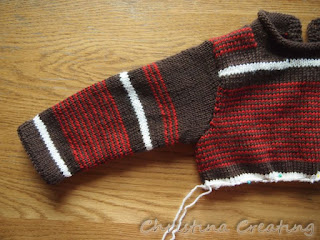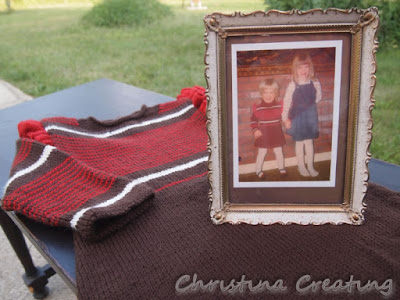Conception
Pattern
Bodice and Collar
Sleeves
The ruffles!
Buttons
Skirt
Putting the two halves together
Blocking
Pics of Finished Dress and Project Stats
I can't believe I haven't written about this project. I have been so excited about it, thought of little else and worked on it a lot over the last
I conceived this project in the spring. A bolt out of the blue as I recall. I've referred to this picture (on the right) of my sister and me before. We love it and she remembers that dress very clearly. Remembers loving to wear it. I have since learned that it was a hand-me-down from friends and was brought as a gift to them from the Netherlands. (That gives me hope it was wool and not acrylic. But it was the 70s, so who knows.)
My sister Patricia's youngest daughter is right about the age that she was in the picture. Wouldn't it be just too much to knit a replica of the dress for her daughter? I hope you hear all the angels singing that I did!
But it had to be done for this winter or she would be too old. I was a little concerned I wouldn't get it done and thought I would enlist another sister's help. Then it became a fun collaboration. Or maybe I should say it was fun to have someone in on the secret. Judy was quite clear that I would be designing and she would be following directions!
I found some yarn in the right colours (and superwash) online and ordered more than I thought I would need. Then I had to wait. Oh it was hard. But I was going to see my family in July and thought it would be best to measure my niece first. I was going to have to design the dress, or at least heavily modify a pattern, so I wanted to know what I was aiming for. Once I had the measurement, Judy and I could start knitting right away!
I originally thought of the project as a secret, but I knew Patricia would rather be in on the secret. Judy wasn't sure, but we did tell her and she was delighted. I knew she would be!
In order to persuade her daughter to let me measure her, I told her about the project as well. She was also delighted. The rest of the weekend, she was completely endearing with her little smile, coy look and question "You making Faithy's dress?"
 |
| Wendy Darling dress |
Once I had the measurements, I worked out what was the closest size of this pattern and used that as a base. With my stitch and row gauge (yes I did a gauge swatch ahead of time. I could at least get that much done while I was waiting to start!) figured out, I could plan the stripes.
The overall plan was for me to work on the bodice and Judy to work on the skirt. Since I wanted to work from the waist up and she would work from the waist down, we both started with a provisional cast on. In the end, the two pieces could be grafted together.
It looks like I don't have any progress pictures. You can just imagine me sitting on a lawn chair knitting in the sun (and shade when it got a little too hot). And you may as well imagine my extended family shaking their heads as I spend a campout knitting.
Here is the bodice when it was knit, sewn at the sides and the collar was added.
Instead of doing a turtleneck like the original, we opted for an extended crew neck with a rolled edge (as a nod to the original's turtleneck).
After a couple rows, I added decreases wherever I felt like they were needed so that the neckband would be shaped and not stand away from the body. I didn't try to line them up. Sometimes I did six in a row, sometimes four or five.
Once that was done, it was time for the sleeves. Again, no progress pictures! I knit them flat and seamed them before sewing them to the bodice.
I started with a turned hem at the wrist.
The sleeves fit into the armseye of the bodice very well:
Now that that was done, it was time to figure out the ruffles. She never said, but I think Judy was a little dubious about the ruffles, but I knew I had to have them. They are a defining element of the dress!
It took me a while (a week?) to think about how I was going to do them. Very back burner thinking, but it works for me. There are a lot of knitted ruffles that don't work, and I wanted to avoid them. I decided I had to pick up stitches at the intersection of the bodice and sleeve and work up from there.
This is the "underside" of the ruffle (toward the sleeve).
I picked up one stitch in every row along the bodice. I didn't go all the way around the sleeve but used the photo as a guide of where to start and stop.
I decided to make the actual ruffles by alternating stocking stitch and reverse stocking stitch sections and by doing a lot of increases.
I started with knit 2, purl 2. Every row after that, I increased two stitches in every stocking stitch section. (I.e. every section where I was knitting.)
It got a little crazy with the number of stitches on my needle.
I finally figured out an adaptation of magic loop and worked with only a fraction of the stitches actually on the needle at one time as I worked across the row.
 |
| I'm working the stitches on the two needles, but all of the stitches on the right are still on the cable too. I just pulled out some length of the cable to give me some working room. |
I also did short rows to shape the ends of the ruffle. Because of the increases, I counted sections for the short rows instead of stitches.
I figured out the short rows by using the height of the final ruffle (so I knew how many rows I had to work in) and how wide I wanted the tallest centre section (that told me how many stitches I wanted to leave unworked in the short rows).
I don't think it could have turned out any better. Look at that ruffle-ly awesomeness:
Until I see Faith wearing the dress and a big smile, this is definitely my favourite part!
Now all that left for my part was the buttons!
I couldn't find three in my brown button jar that were the same, but I didn't let that bother me. I used a pair for the bottom and finished with a dressier one on top:
I backed them all with tiny buttons. (Three the same this time.)
This is needed to properly anchor the buttons on the knit fabric. It also softens the feeling of a shank button (as the top one is). If you've ever made the mistake of using a shank button on your back (ahem who would ever do that?), you know that it pokes you and is very uncomfortable! With this button behind it, it doesn't poke!
Also, did you know that buttons of any size have the same spaced holes in the middle? They're all the same. That seems crazy to me, but it also makes sense. It must make manufacturing easier. It also makes it easy to sew two buttons together even when they're different sizes and separated by a layer of knit fabric. You can just go straight up and down with each pass and neatly catch the corresponding hole in each button.
Then I was ready for the skirt from Judy and she was ready to mail it. She had started it at the campout as well, but mostly so she could get past the red stripe and didn't need to bring any colour but brown with her. I didn't give her enough and ended up having to mail her more. A minor speed bump.
We also had to solve a problem with the increases. She was supposed to increase all the way down the length of the skirt. But when she was at about 2/3 of the length, she was done all the increases. We decided she couldn't just keep making the skirt wider, so she had to rip out all but about six rows!
Her row gauge was different than mine and that's what we get for not doing a swatch. She ripped it back like a trooper and increased at a slower rate. We had one long conversation where we were trying to figure out how many rows she should add between increases. She said, "Oh...I'll just go from 4 to 5." I said, no we have to do the math.
I proceeded to go through a lot of math, arrive at the wrong answer, realize my mistake, and then arrive at the right answer....which was 5 rows. I still think it was worth doing. I like to arrive at the same answer by two different methods. It's more likely to be right. And in this case it was.
Judy sent the finished skirt in the mail.
She didn't get the most exciting job knitting that expanse of brown, but she did a beautiful job.
The bottom was finished with a turned hem, just like on the sleeves.
I didn't get home until late the day the package arrived, so I had to content myself with a mock up of the dress instead of being able to join the two pieces:
I heard a report that Faith saw this on Instagram and was very excited. :)
The next day, as soon as I could, I sat down and worked on putting the two parts together.
I put the live stitches from each piece onto a skinny circular needle one half at a time. That was insurance so that I would match up the side seams on both sides. I was pleasantly and mildly surprised that we ended up with the exact number stitches on each piece. It went together beautifully!
Then it was time for a bath and light blocking.
It's superwash so it should have been fine in the machine, but there was no need for that. I soaked it in the sink, squeezed out the water, and then rolled it in a towel to get the water out. I didn't pin anything in place, but just laid it flat on the mesh. Those ruffles took a little while to dry! :)
Here are pictures of the finished dress. I'll be sure to add one of Faith wearing it when I get one, but that will be a little while. (I know--I can't wait either!)
I may do more intricate projects than this. I may do more impressive projects. More artistic projects. But right now I can't believe I'll ever do a project I'll love more. The idea, the perfect timing, the connection to the past, the collaboration, the result (assuming it fits!)...can't be beat.
Project Stats
Started: 28 Jul '17
Finished: 20 Aug '17
Pattern: Personal pattern with a lot of help from the Wendy Darling dress from Drops Designs.
Materials: Knit Picks Swish DK in 24632 Serrano (2 balls) and 24633 Bark (5 balls) and a bit of unknown white from stash.
Co-creator: Sister Judy
As promised, here is the picture of Faith in the dress:
At Christmas, the three of us could get together for a pic:
























































